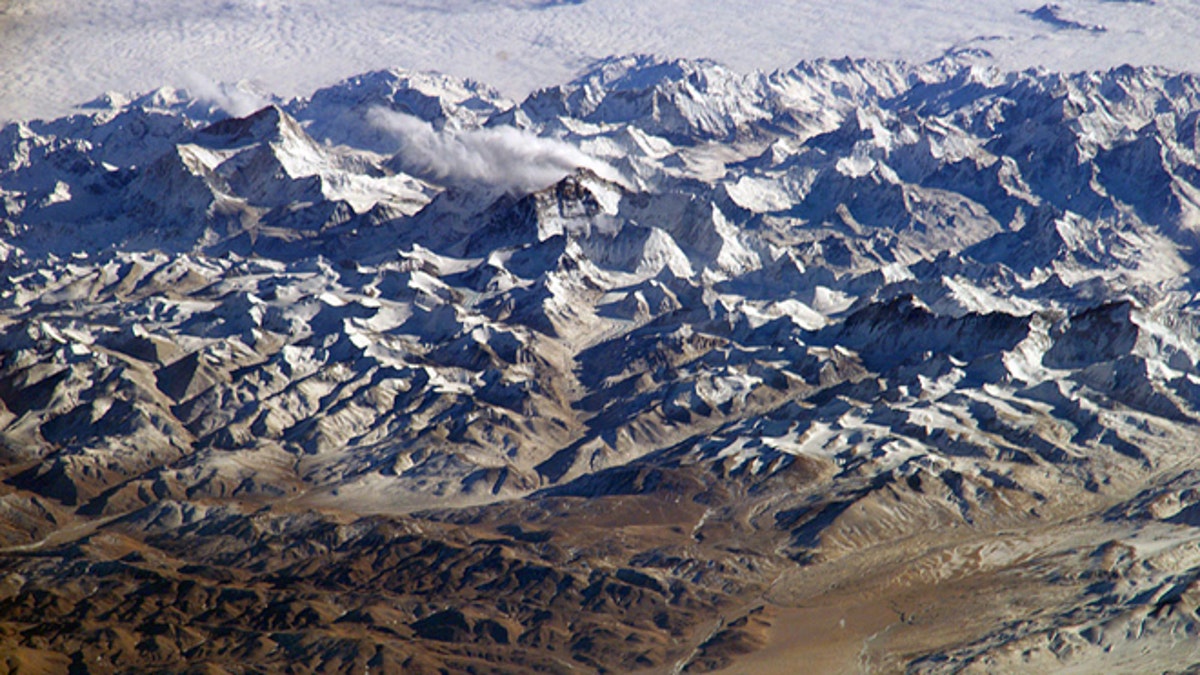
Astronauts on board the International Space Station recently took advantage of their unique vantage point to photograph the Himalayas, looking south from over the Tibetan Plateau. Mt. Everest (29,035 feet) is at right. (NASA)
A new study reveals that some Himalayan glaciers in the Karakoram mountain range may actually be getting bigger, according to a study published in the April issue of the journal Nature Geoscience -- a surprising quirk in the planet’s response to a changing climate.
The Karakoram range runs along the India-China-Pakistan border and is home to about half the volume of the Himalayan glaciers, including K2 -- the world's second highest peak. Using computer models to compare the ice volume in satellite photos from 1999 and 2008, the study showed that some glaciers are holding steady and even gaining ice mass.
The new finding appears to align with another startling report published Feb. 9 in the science journal Nature, which found that the Himalayas have barely melted at all in the past 10 years.
[pullquote]
Yet the surprising growth of some glaciers isn’t commonplace, said study researcher Julie Gardelle, of CNRS-Université Grenoble, France. She told LiveScience that the larger trend was clear: all the other glaciers are melting.
"The rest of the glaciers in the Himalayas are mostly melting, in that they have negative mass balance; here we found that glaciers aren't," Gardelle told LiveScience. "This is an anomalous behavior."
The earlier study disagreed.
The Nature report offered the first comprehensive study of the world’s glaciers and ice caps, using GRACE -- a pair of orbiting satellites racing around the planet at an altitude of 300 miles. That study concluded that the Himalayas have barely melted at all in the past 10 years.
"The GRACE results in this region really were a surprise," said University of Colorado at Boulder physics Prof. John Wahr, who led the study.
Glaciologist Jonathan Bamber (who was not part of the research team) cautioned that the Nature study doesn't alter his view that the climate is changing.
“This new study doesn't change our view of the risks and threats from climate change,” he said in an online chat at the Guardian. “What it does do is improve our knowledge of the recent behavior of one part of the climate system.”
Indeed, Wahr’s study clearly notes that lower-altitude glaciers and ice caps are melting, to the tune of about 150 billion tons of ice annually, which the study predicts could lead to an overall rise in sea levels. He concluded that the higher altitude and therefore colder Himalayan peaks may be temporarily impervious to factors causing melting.
"One possible explanation is that previous estimates were based on measurements taken primarily from some of the lower, more accessible glaciers in Asia and were extrapolated to infer the behavior of higher glaciers. But unlike the lower glaciers, many of the high glaciers would still be too cold to lose mass even in the presence of atmospheric warming," Wahr said.
Glaciers grow and shrink based on how much snow falls and the temperatures in the area, LiveScience said. Why the Karakoram range isn't melting is still a mystery. "For now we don't have any explanation," Gardelle said. "There's been a study reporting an increase in winter precipitation; this could maybe be a reason for the equilibrium, but that's just a guess."
The United Nations’ climate arm warned incorrectly in 2007 that the Himalayan glaciers would melt completely in 25 years, vanishing by the year 2035 due to the effects of climate change.
Rajendra Pachauri, head of the U.N.'s Intergovernmental Panel on Climate Change (IPCC) and director general of the Energy and Resources Institute (TERI) in New Dehli, India, ultimately issued a statement offering regret for what turned out to be a poorly vetted statement.
